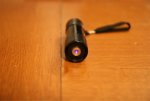The 10 ohm resistor, on which you're measuring the current (by measuring the voltage drop, right?), does not affect the current, but it does introduce a voltage drop, that changes with the current, and means that your driver requires a higher input voltage, than it would, without that resistor. Still, if you give the driver enough voltage, the resistor will not affect the current.
But with 7.2V you were simply at too low voltage. 7.2V is good for reds.. I don't know the exact Vf of the 0811 diode, but the PHR needs >5V, almost 6V by itself, depending on the current. The 317 needs 3V on top of that, so 9V is really the bare minimum - 9V is the voltage your battery should have when empty. When full it should have more, so that the driver can keep your current constant over the entire battery voltage range.
Still it should work at least at the start.. Is your 9V battery full? Measure it's voltage under load.
In any case, you need three Li-Ions for it to work for any real amount of time.
Then you need to set the pot to the MAX resistance FIRST, because then the current actually will be what you set it to, and kill your diode, as the driver jumps into regulation. Right now it's not regulating, which is why you can't set the current properly. At the moment, your driver is set to 2.5A (0.5 ohm) theoretically. Not that it can deliver that much, especially not from a 9V battery.
Set the pot to max resistance and give the driver what it needs, then adjust again. The 6V mentioned in the tutorial is the minimum for red diodes, not for blu.
And the two 10 ohm resistors in parallel mean, your max current is limited to just under 250mA, which is too much. Use only one 10 ohm, and your max current will be slightly under 125mA, which at least won't kill your diode instantly, if you don't set the pot right.
The reason it works with a LED is because of it's much lower voltage requirements, compared to a blu diode. There, the driver gets enough voltage on top of what the LED needs, to regulate the current.





